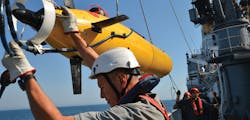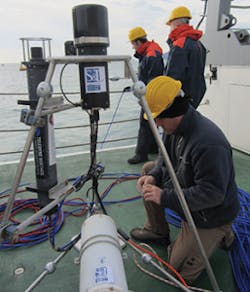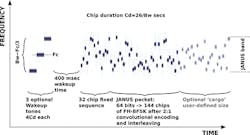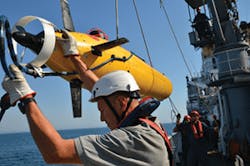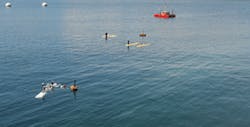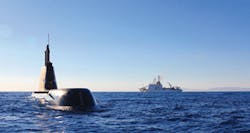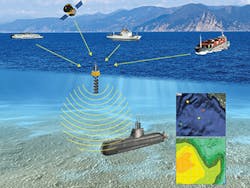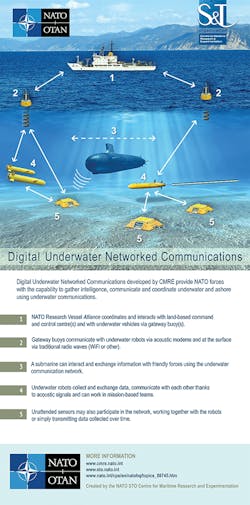IoT Under the Sea!
Tests of JANUS were conducted using the CMRE Littoral Ocean Observatory Network (LOON), a test bed made by acoustic tripods forming an underwater acoustic network, ideal for low-cost experimentation of underwater communication schemes. Here, one of the LOON tripods is being deployed in the Gulf of La Spezie in Italy.
Satellites and mobile phones, built on international standards, help the world get connected. But the communications technology we use on land does not work well underwater. The North Atlantic Treaty Organization (NATO) has sponsored research into establishing the first ever digital underwater communications standard.
Imagine a scuba diver approaching the surface, being made aware of nearby boating activity; or a submarine communicating with a land-based command post; or an underwater robot sending a warning to an oil rig after a leak is detected. The possible applications of underwater communications are limitless.
It could be used in many areas: for harbor protection, maritime surveillance, mine detection, surveying offshore wind farms and pipelines, or even underwater archaeology.
The NATO Science and Technology Organization’s Centre for Maritime Research and Experimentation (CMRE) has developed a standard for underwater acoustic communications called JANUS, which is recognized as a NATO standard by all NATO Allies since March 2017. This marks the first time that a digital underwater communication protocol has been acknowledged at international level, and opens the way to develop many exciting underwater communication applications.
The CMRE has developed JANUS, the first digital standard for underwater acoustic communications, promulgated as a NATO Standard since March 2017. JANUS works like a baseline common denominator which consists of a robust signaling acoustic method and allows underwater assets to understand each other.
A Network of Marine Robots
We are working to support effective underwater communication networks to allow undersea robots to work together and report back home. We are working to help robots behave intelligently and act as a team. For example, one of the robots could find some interesting feature and call the rest of the team.
Experiments include tests with autonomous underwater vehicles (AUVs), and the development of new solutions to empower networks of robots and enable full interoperability among underwater assets. Here, an Ocean Explorer AUV is recovered from the NATO Research Vessel Alliance during a sea trial.
With effective undersea communication, this can all happen in an autonomous way, without requiring direct human intervention. If needed, the operation can be managed by land-based engineers who monitor all the communications from a command and control room ashore. The connection to land is made through gateway buoys on the surface of the water equipped with radio links to local support platforms or satellites.
This is particularly important for search-and-rescue operations. Autonomous vehicles are relatively inexpensive and, of course, unmanned, so they can be sent to do dirty, dangerous jobs. And because sound is known to have an impact on marine life, we work with biologists and other scientists to protect the marine environment.
Much of this development work is carried out on the Littoral Ocean Observatory Network, or LOON. (See sidebar "What’s a LOON?" for more information.) The LOON is a test facility, installed in the harbor of La Spezia, Italy, that plays a central role in NATO projects, many of which are developed in partnership with the European Commission.
[toggle title=”What’s a LOON?” load=”hide”]Undersea Lingo
Littoral Ocean Observatory Network (LOON): a low-cost permanent and web-based test bed — enables users
(international institutions, research groups, and commercial entities) across the world to test underwater communication schemes.
• Acoustic communications equipment deployed on the seabed forms an underwater acoustic network.
• Individual nodes of the network connected to shore with cables enable remote control by engineers and scientists.
• Used extensively in support of the development of JANUS and for CMRE’s research in underwater.[/toggle]
CMRE uses the LOON to develop and test communication solutions that contribute to the protection and monitoring of oceans and rivers by underwater robots.
Behavior and capabilities of teams of intelligent robots depend on their capacity to communicate with each other using acoustic signals and to dynamically adapt their missions, without human intervention. However, underwater communication is challenging and until now there was no unique way to do it. Here, a network of underwater robots during a test of the European Commission FP7 MORPH project on which CMRE collaborated.
JANUS = Underwater Language
To communicate with each other, underwater assets need common standards. In the air we can simply connect our gadgets to any Wi-Fi hotspot without having to worry about the compatibility. Until now, there wasn’t anything even remotely similar for the underwater domain.
As with the industry standard for Wi-Fi communication, an undersea communication standard had to be defined in order to guarantee the interoperability between equipment from different manufacturers.
For the past 10 years, CMRE has been working on the development of the first international digital underwater communication protocol, known as JANUS, which is now an approved NATO standard.
As an example, the Portuguese Navy has been working with CMRE to develop new concepts to support the exchange of crucial information with submarines (typically only available at the surface via radio) such as the location of nearby ships. Digital exchanges to support rescue operations in case of a submarine accident are currently being developed. Here, the foreground shows a Portuguese submarine. In the background, a NATO Research Vessel Alliance operated by CMRE, along with the Italian Navy, during an underwater communications sea trial in the Atlantic Ocean.
John Potter, a strategic development officer with the organization and a former project leader for JANUS shares how we came up with the name: "JANUS was a Roman god of openings and gateways. This language opens the portal between 2 domains — 2 different operating paradigms, through which they can talk. It is a digital underwater signaling system that can be used to contact underwater devices using a common format; announce the presence of a device to reduce conflicts; and enable a group of underwater devices (that can be underwater robots, submarines, divers or any other equipment operating under the surface) to organize themselves into a network."
Adopted globally, JANUS can make military and civilian, NATO and non-NATO devices, interoperable, providing them all with a common language with which to communicate and arrange to cooperate.
The language has been extensively tested at sea in exercises involving a number of partners (universities, industries, and research institutions) covering a range of application scenarios. Close collaboration with NATO Allies has been particularly fruitful in developing it for use in cases that may improve the safety of maritime operations.
Applications of JANUS are limitless. The scheme shows AIS data (top box on the right) and METOC (bottom box on the right) information being delivered to a submarine using JANUS acoustic communication.
Save
Save
Save
Save
Save
Save
